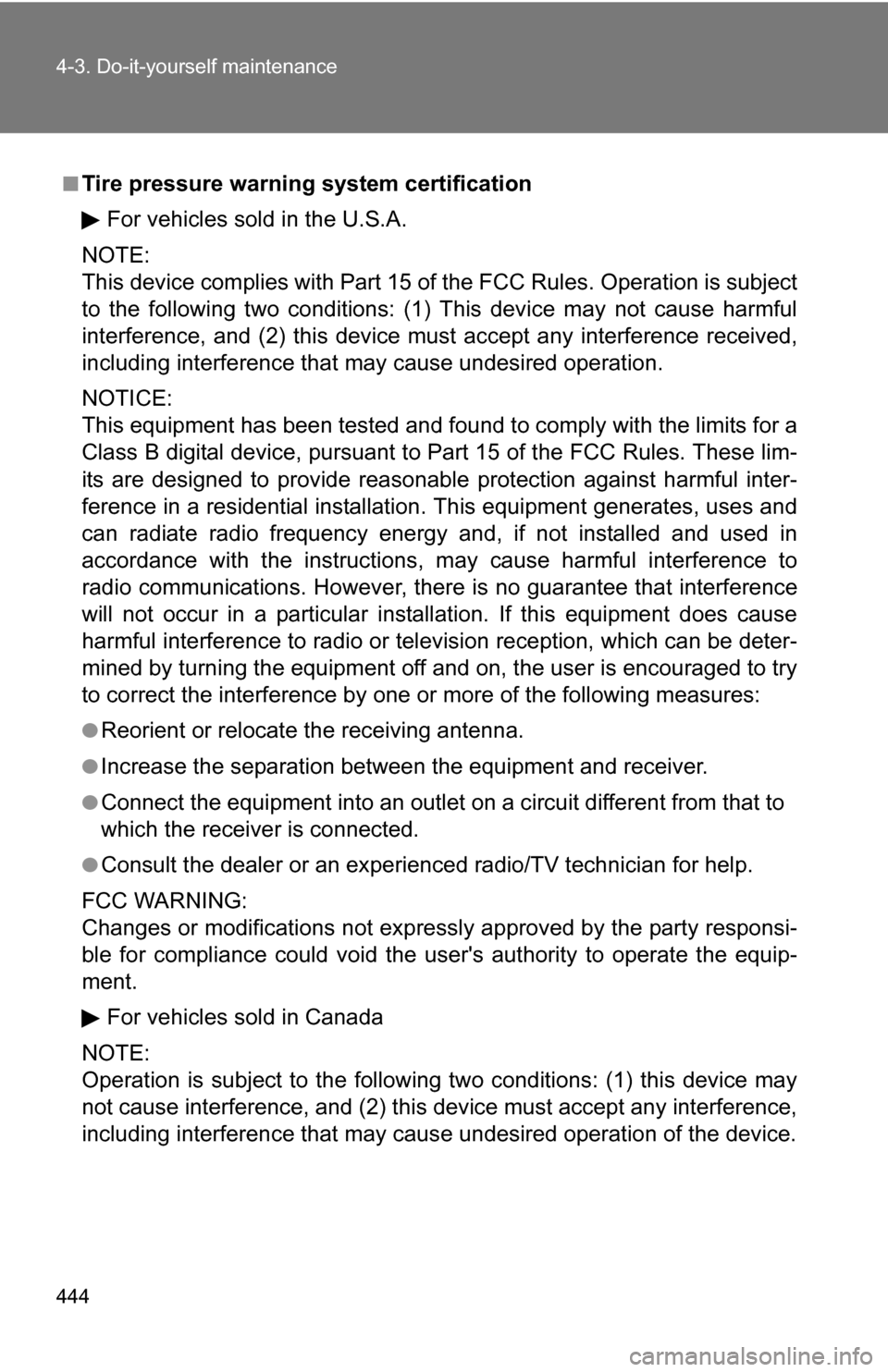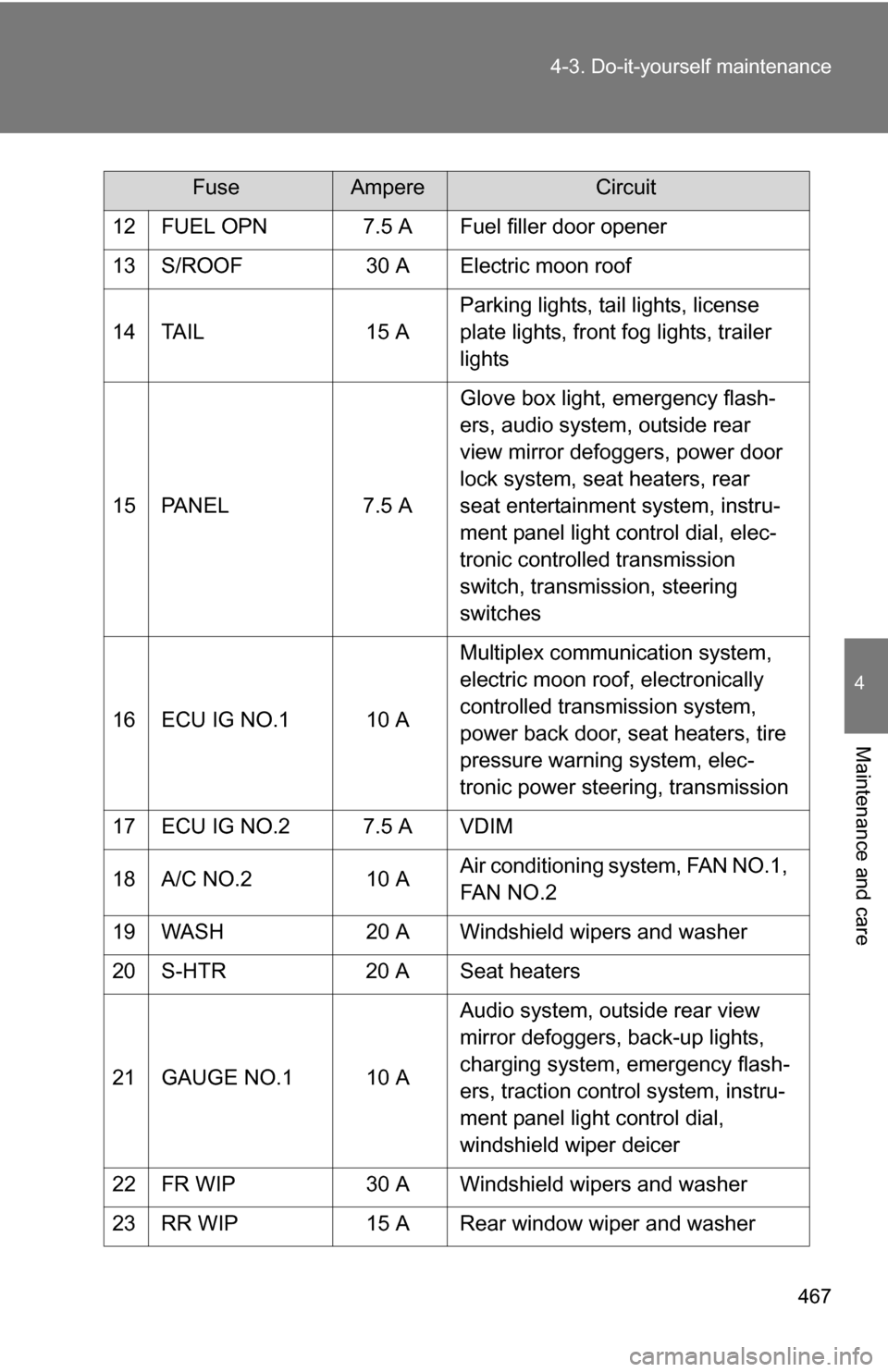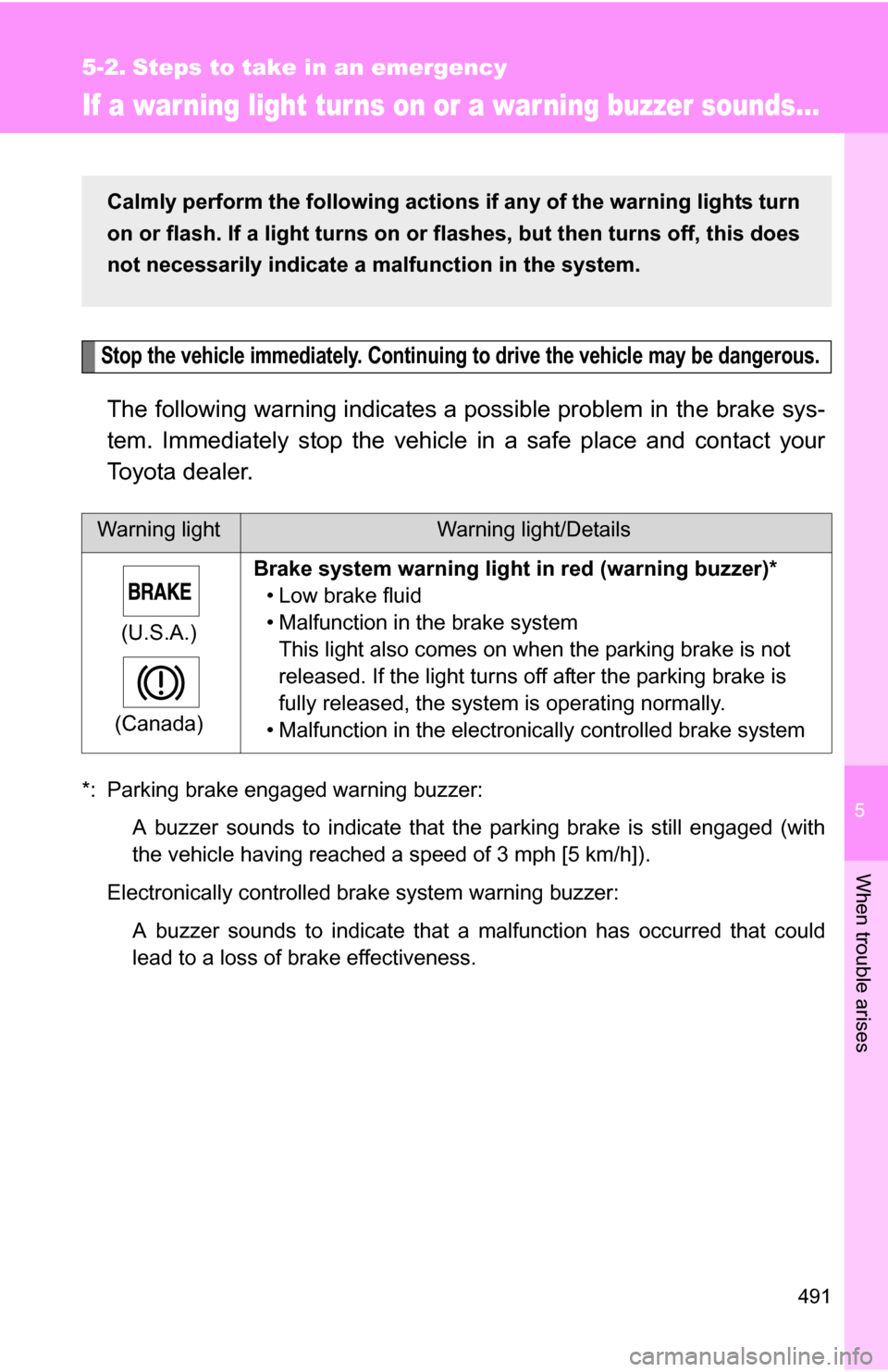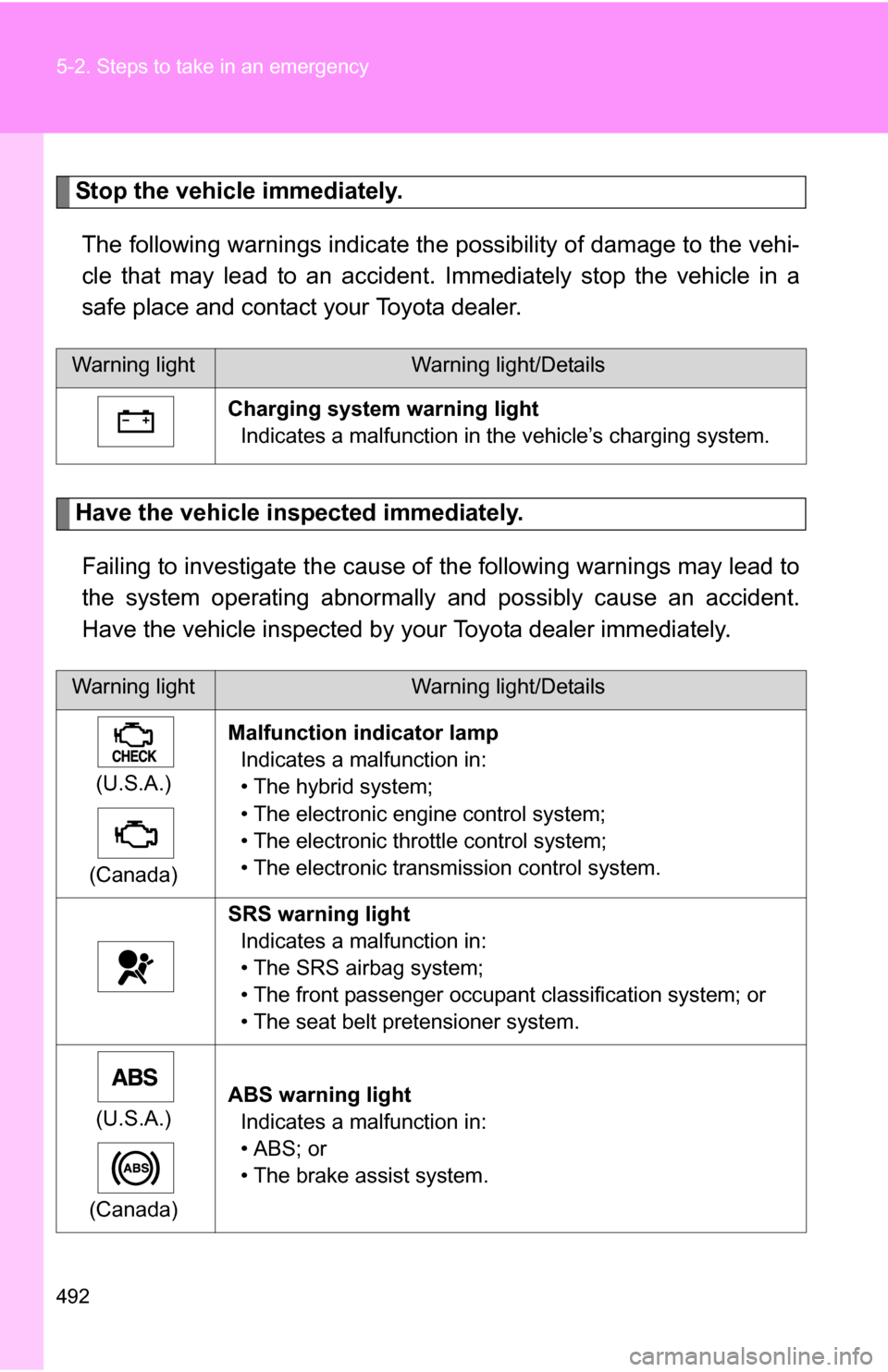Page 444 of 580

444 4-3. Do-it-yourself maintenance
■Tire pressure warning system certificationFor vehicles sold in the U.S.A.
NOTE:
This device complies with Part 15 of the FCC Rules. Operation is subject
to the following two conditions: (1) This device may not cause harmful
interference, and (2) this device must accept any interference received,
including interference that may cause undesired operation.
NOTICE:
This equipment has been tested and found to comply with the limits for a
Class B digital device, pursuant to Pa rt 15 of the FCC Rules. These lim-
its are designed to provide reasonable protection against harmful inter-
ference in a residential installation . This equipment generates, uses and
can radiate radio frequency energy and, if not installed and used in
accordance with the instructions, may cause harmful interference to
radio communications. However, there is no guarantee that interference
will not occur in a particul ar installation. If this equipment does cause
harmful interference to radio or television reception, which can be deter-
mined by turning the equipment off and on, the user is encouraged to try
to correct the interference by one or more of the following measures:
●Reorient or relocate the receiving antenna.
●Increase the separation between the equipment and receiver.
●Connect the equipment into an outlet on a circuit different from that to
which the receiver is connected.
●Consult the dealer or an experienced radio/TV technician for help.
FCC WARNING:
Changes or modifications not expre ssly approved by the party responsi-
ble for compliance could void the user's authority to operate the equip-
ment.
For vehicles sold in Canada
NOTE:
Operation is subject to the following two conditions: (1) this device may
not cause interference, and (2) this de vice must accept any interference,
including interference that may caus e undesired operation of the device.
Page 446 of 580
446 4-3. Do-it-yourself maintenance
NOTICE
■Repairing or replacing tires, wheels and tire pressure warning
valves and transmitters
●When removing or fitting the wheels, tires or the tire pressure warning
valve and transmitter, contact your Toyota dealer as the tire pressure
warning valve and transmitter may be damaged if not handled cor-
rectly.
■To avoid damaging the tire pressure warning valves and transmit-
ters
Do not use liquid sealants on flat tires.
■Driving on rough roads
Take particular care when driving on roads with loose surfaces or pot-
holes.
These conditions may cause losses in tire inflation pressure, reducing
the cushioning ability of the tires. In addition driving on rough roads may
cause damage to the tires themselves, as well as the vehicle's wheels
and body.
■If tire inflation pressures become low while driving
Do not continue driving, or your tires and/or wheels may be ruined.
Page 451 of 580

451
4-3. Do-it-yourself maintenance
4
Maintenance and care
Wheels
■When replacing wheels
The wheels of your Toyota are equipped with sensors that allow the tire
pressure warning system to provide advanced warning in the event of a
loss in tire inflation pressure. Whenever wheels are replaced, the tire
inflation pressure warning valve & transmitter must be switched over
from the old wheels. (P. 441)
If a wheel is bent, cracked or heavily corroded, it should be
replaced.
Otherwise, the tire may separate from the wheel or cause loss of
handling control.
■ Wheel selection
When replacing wheels, care should be taken to ensure that
they are equivalent to those removed in load capacity, diameter,
rim width, and offset.
Replacement wheels are available at your Toyota dealer.
Toyota does not recommend using:
●Wheels of different sizes or types
● Used wheels
● Bent wheels that have been straightened
■ Aluminum wheel precautions
●Use only Toyota wheel nuts and wrenches designed for use
with your aluminum wheels.
● When rotating, repairing or changing your tires, check that the
wheel nuts are still tight after driving 1000 miles (1600 km).
● Be careful not to damage the aluminum wheels when using
tire chains.
● Use only Toyota genuine balance weights or equivalent and a
plastic or rubber hammer when balancing your wheels.
Page 452 of 580
452 4-3. Do-it-yourself maintenance
CAUTION
■When replacing wheels
●Do not use wheels that are a different size from those recommended in
the Owner’s Manual, as this may result in loss of handling control.
●Never use an inner tube in a leaking wheel which is designed for a
tubeless tire. Doing so may result in an accident, causing serious
injury or death.
NOTICE
■Replacing tire pressure warning valve & transmitters
●Because tire repair or replacement may affect the tire pressure warn-
ing valve & transmitters, make sure to have tires serviced by your
Toyota dealer or other qualified service shop. In addition, make sure to
purchase your tire pressure warning valve & transmitters at your
Toyota dealer.
●Ensure that only Genuine Toyota wheels are used on your vehicle.
Tire pressure warning valve & transmitters may not work properly with
non-genuine wheels.
Page 467 of 580

467
4-3. Do-it-yourself maintenance
4
Maintenance and care
12 FUEL OPN 7.5 A Fuel filler door opener
13 S/ROOF 30 A Electric moon roof
14 TAIL 15 A
Parking lights, tail lights, license
plate lights, front fog lights, trailer
lights
15 PANEL 7.5 A Glove box light, emergency flash-
ers, audio system, outside rear
view mirror defoggers, power door
lock system, seat heaters, rear
seat entertainment system, instru-
ment panel light control dial, elec-
tronic controlled transmission
switch, transmission, steering
switches
16 ECU IG NO.1 10 A Multiplex communication system,
electric moon roof, electronically
controlled transmission system,
power back door, seat heaters, tire
pressure warning system, elec-
tronic power steering, transmission
17 ECU IG NO.2 7.5 A VDIM
18 A/C NO.2 10 A Air conditioning system, FAN NO.1,
FAN NO.2
19 WASH 20 A Windshield wipers and washer
20 S-HTR 20 A Seat heaters
21 GAUGE NO.1 10 A Audio system, outside rear view
mirror defoggers, back-up lights,
charging system, emergency flash-
ers, traction control system, instru-
ment panel light control dial,
windshield wiper deicer
22 FR WIP 30 A Windshield wipers and washer
23 RR WIP 15 A Rear window wiper and washer
FuseAmpereCircuit
Page 481 of 580
When trouble arises5
481
5-1. Essential information .... 482If your vehicle needs to be towed ........................ 482
If you think something is wrong ............................. 488
Event data recorder ......... 489
5-2. Steps to take in an emergency .................... 491
If a warning light turns on or a warning buzzer
sounds... ....................... 491
If a warning message is displayed........................ 500
If you have a flat tire......... 501
If the hybrid system will not start .......................... 513
If the shift lever cannot be shifted from P............ 515
If you lose your keys ........ 516
If the electronic key does not operate properly
........ 517
If the vehicle 12-volt battery is discharged .................. 519
If your vehicle overheats ....................... 523
If the vehicle becomes stuck .............................. 527
Page 491 of 580

5
When trouble arises
491
5-2. Steps to take in an emergency
If a war ning light turns on or a war ning buzzer sounds...
Stop the vehicle immediately. Continuing to drive the vehicle may be dangerous.
The following warning indicates a possible problem in the brake sys-
tem. Immediately stop the vehicle in a safe place and contact your
Toyota dealer.
*: Parking brake engaged warning buzzer:
A buzzer sounds to indicate that the parking brake is still engaged (with
the vehicle having reached a speed of 3 mph [5 km/h]).
Electronically controlled brake system warning buzzer:
A buzzer sounds to indicate that a malfunction has occurred that could
lead to a loss of brake effectiveness.
Warning lightWarning light/Details
(U.S.A.)
(Canada) Brake system warning light
in red (warning buzzer)*
• Low brake fluid
• Malfunction in the brake system This light also comes on when the parking brake is not
released. If the light turns off after the parking brake is
fully released, the system is operating normally.
• Malfunction in the electronically controlled brake system
Calmly perform the following actions if any of the warning lights turn
on or flash. If a light turns on or flashes, but then turns off, this does
not necessarily indicate a malfunction in the system.
Page 492 of 580

492 5-2. Steps to take in an emergency
Stop the vehicle immediately.The following warnings indicate the possibility of damage to the vehi-
cle that may lead to an accident. Immediately stop the vehicle in a
safe place and contact your Toyota dealer.
Have the vehicle inspected immediately.Failing to investigate the cause of the following warnings may lead to
the system operating abnormally and possibly cause an accident.
Have the vehicle inspected by your Toyota dealer immediately.
Warning lightWarning light/Details
Charging system warning light Indicates a malfunction in the vehicle’s charging system.
Warning lightWarning light/Details
(U.S.A.)
(Canada) Malfunction indicator lamp
Indicates a malfunction in:
• The hybrid system;
• The electronic engine control system;
• The electronic throttle control system;
• The electronic transmission control system.
SRS warning light Indicates a malfunction in:
• The SRS airbag system;
• The front passenger occupant classification system; or
• The seat belt pretensioner system.
(U.S.A.)
(Canada) ABS warning light
Indicates a malfunction in:
•ABS; or
• The brake assist system.